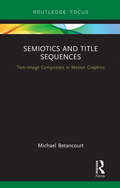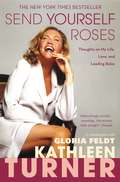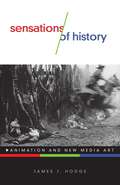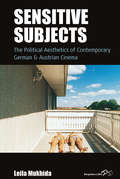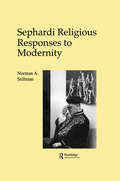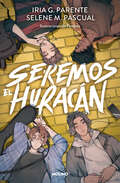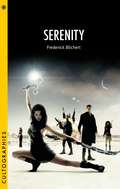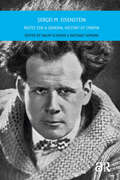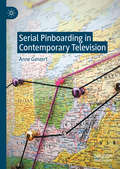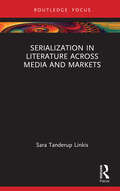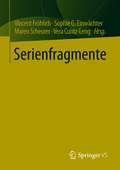- Table View
- List View
Semi-Detached
by Griff Rhys JonesSemi-detached Griff relives freezing bus journeys to school and the impulsive stealing of that half-a-crown from Charlie Hume’s money box; sitting outside Butlins at Clacton (longing to be inside and on the Waltzer instead of stranded on the pebbles with his dad); hazy summer afternoons spent with feral gangs in the woods, or storming the mud flats singing extracts from the Bonzo Dog Dooh Dah Band. The memories are like Mivvis, frozen and fuzzy at the edges, but a sweet jam of pure recollected goo at the centre.From birth to the BBC, this is a story of a confident middle child. Griff’s devoted parents Gwynneth and Elwyn gave him love, security and plenty of asparagus soup from a fake wicker vacuum flask with a plastic top. Griff’s father Elwyn, a retiring hospital doctor with a penchant for sweeties and ice-cream, loathed the tedium of English social ritual and hid behind his family and woodwork. From tree houses to boats, puppets to tables, he sawed and hammered his way into his family’s affections.Griff left the bosom of his loving, irascible, eccentric, solid, all engulfing family for the firm embrace of real life; via the Upminster Fun Gang, the Direct Grant System and Party Sevens, losing his virginity down the back of a bunk in a twenty nine foot yacht, discovering the romantic advantages of shared babysitting engagements and the drawbacks of infatuation with identical twins. If he hadn’t moved around so much as a child, would Griff have felt less like a voyeur, looking in on the lighted window across the square, the Georgian house glowing in the sun, the clink of glasses and the bray of public school certainties? Would he be able to tuck in his own shirt? Would he be fully detached? A laugh-aloud buffet of baby boomer Britain, Griff’s self-deprecating, elegant, affectionate prose reveals a little bit better how on earth you got from there to here.
Semiotics and Title Sequences: Text-Image Composites in Motion Graphics (Routledge Studies in Media Theory and Practice)
by Michael BetancourtTitle sequences are the most obvious place where photography and typography combine on-screen, yet they are also a commonly neglected part of film studies. Semiotics and Title Sequences presents the first theoretical model and historical consideration of how text and image combine to create meaning in title sequences for film and television, before extending its analysis to include subtitles, intertitles, and the narrative role for typography. Detailed close readings of classic films starting with The Cabinet of Dr. Caligari, and including To Kill A Mockingbird, Dr. Strangelove, and The Good, the Bad and the Ugly, along with designs from television programs such as Magnum P.I., Castle, and Vikings present a critical assessment of title sequences as both an independent art form and an introduction to the film that follows.
Send Yourself Roses: Thoughts on My Life, Love, and Leading Roles
by Gloria Feldt Kathleen TurnerFrom her film debut as the sultry schemer in Body Heat to her award-winning role as Martha in Who's Afraid of Virginia Woolf?, actress Kathleen Turner's unique blend of beauty, intelligence, and raw sexuality has driven her personal and professional life. Now, in this gutsy memoir, the screen icon tells us of the risks she's taken and the lessons she's learned-sometimes the hard way. For the first time, Turner shares her childhood challenges-a life lived in countries around the world until her father, a State Department official whom she so admired, died suddenly when she was a teenager. She talks about her twenty year marriage, and why she and her husband recently separated, her close relationship with her daughter, her commitment to service, and how activism in controversial causes has bolstered her beliefs. And Turner reveals the pain and heartbreak of her struggle with rheumatoid arthritis, and how, in spite of it, she made a daring decision: to take a break from the movies and relaunch her stage career. Along the way, Turner describes what it's like to work with legends like Jack Nicholson, Michael Douglas, William Hurt, Steve Martin, Francis Ford Coppola, John Huston, John Waters, Edward Albee...and, with characteristic irreverent humor, shares her behind-the-screen stories of dealing with all types of creative, intimidating, and inspiring characters. Kathleen Turner has always known that she would play the lead in the story of her life. It's impossible not to take her lessons on living, love, and leading roles to heart. And it won't be long until you'll be sending yourself roses!
Send in the Clowns: Humanitarian Clowning in Crisis Zones
by David Bridel Mike FuntSend in the Clowns presents interviews with twenty-four pioneering humanitarian and activist clowns and thought leaders working in hospitals, refugee camps, orphanages and war zones, and at the sites of street protests and locations of social unrest across the world.This book is built around interviews with some of the world’s leading practitioners of clowning for change, justice, and health outside of the entertainment mainstream, featuring artists and organizations including Patch Adams (US), the Dream Doctors Project (Israel), Clown Me In (Lebanon), and Doutores da Alegria (Brazil). Situating the topic in relation to indigenous and ritual clowning, investigating the various functions of the clown in early societies, and centering the discourse around interviews with key practitioners, the book explores a wide range of clown applications across the globe. This includes the special significance of the clown archetype in socially, politically, and culturally challenging situations, the successes and challenges of the art activists who are at the forefront of this movement, and the modern humanitarian clown’s relationship to original forms of clowning that can be traced back through history.This is a vital resource for anyone studying, teaching, or practicing clown work in applied contexts, from health care to conflict resolution.
Seneca's Oedipus
by Ted Hughes Lucius Annaeus SenecaSophocles' Oedipus Tyrannus is the most famous of ancient tragedies and a literary masterpiece. It is not, however, the only classical dramatization of Oedipus' quest to discover his identity. Between four and five hundred years after Sophocles' play was first performed, Seneca composed a fine, but neglected and often disparaged Latin tragedy on the same subject, which, in some ways, comes closer to our common understanding of the Oedipus myth. Now, modern readers can compare the two versions, in new translations by Frederick Ahl. Balancing poetry and clarity, yet staying scrupulously close to the original texts, Ahl's English versions are designed to be both read and performed, and are alert to the literary and historical complexities of each. In approaching Sophocles anew, Ahl is careful to preserve the richly allusive nature and rhetorical power of the Greek, including the intricate use of language that gives the original its brilliant force. For Ahl, Seneca's tragedy is vastly and intriguingly different from that of Sophocles, and a poetic masterpiece in its own right. Seneca takes us inside the mind of Oedipus in ways that Sophocles does not, making his inner conflicts a major part of the drama itself in his soliloquies and asides. Two Faces of Oedipus opens with a wide-ranging introduction that examines the conflicting traditions of Oedipus in Greek literature, the different theatrical worlds of Sophocles and Seneca, and how cultural and political differences between Athenian democracy and Roman imperial rule affect the nature and conditions under which the two tragedies were composed. This book brings two dramatic traditions into conversation while providing elegant, accurate, and exciting new versions of Sophocles' and Seneca's tragedies.
Sensations of History: Animation and New Media Art (Electronic Mediations #57)
by James J. HodgeA phenomenological investigation into new media artwork and its relationship to history What does it mean to live in an era of emerging digital technologies? Are computers really as antihistorical as they often seem? Drawing on phenomenology&’s investigation of time and history, Sensations of History uses encounters with new media art to inject more life into these questions, making profound contributions to our understanding of the digital age in the larger scope of history.Sensations of History combines close textual analysis of experimental new media artworks with in-depth discussions of key texts from the philosophical tradition of phenomenology. Through this inquiry, author James J. Hodge argues for the immense significance of new media art in examining just what historical experience means in a digital age. His beautiful, aphoristic style demystifies complex theories and ideas, making perplexing issues feel both graspable and intimate.Highlighting underappreciated, vibrant work in the fields of digital art and video, Sensations of History explores artists like Paul Chan, Phil Solomon, John F. Simon, and Barbara Lattanzi. Hodge&’s provocative interpretations, which bring these artists into dialogue with well-known works, are perfect for scholars of cinema, media studies, art history, and literary studies. Ultimately, Sensations of History presents the compelling case that we are not witnessing the end of history—we are instead seeing its rejuvenation in a surprising variety of new media art.
Sensing the Rhythm: Finding My Voice in a World Without Sound
by Mark Atteberry Mandy HarveyThe inspiring true story of Mandy Harvey—a young woman who became deaf at age nineteen while pursuing a degree in music—and how she overcame adversity and found the courage to live out her dreams.When Mandy Harvey began her freshman year at Colorado State University, she could see her future coming together right before her eyes. A gifted musician with perfect pitch, she planned to get a music degree and pursue a career doing what she loved. But less than two months into her first semester, she noticed she was having trouble hearing her professors. In a matter of months, Mandy was profoundly deaf. With her dreams so completely crushed, Mandy dropped out of college and suffered a year of severe depression. But one day, things changed. Mandy’s father asked her to join him in their once favorite pastime—recording music together—and the result was stunningly beautiful. Mandy soon learned to sense the vibrations of the music through her bare feet on a stage floor and to watch visual cues from her live accompaniment. The result was that she now sings on key, on beat, and in time, performing jazz, ballads, and sultry blues around the country. Full of inspiring wisdom and honest advice, Sensing the Rhythm is a deeply moving story about Mandy’s journey through profound loss, how she found hope and meaning in the face of adversity, and how she discovered a new sense of passion and joy.
Sensitive Subjects: The Political Aesthetics of Contemporary German and Austrian Cinema (Film Europa #23)
by Leila MukhidaBoth politically and aesthetically, the contemporary German and Austrian film landscape is a far cry from the early days of the medium, when critics like Siegfried Kracauer produced foundational works of film theory amid the tumult of the early twentieth century. Yet, as Leila Mukhida demonstrates in this innovative study, the writings of figures like Kracauer and Walter Benjamin in fact remain an undervalued tool for understanding political cinema today. Through illuminating explorations of Michael Haneke, Valeska Grisebach, Andreas Dresen, and other filmmakers of the post-reunification era, Mukhida develops an analysis centered on film aesthetics and experience, showing how medium-specific devices like lighting, sound, and mise-en-scène can help to cultivate political sensitivity in spectators.
Sensory Theatre: How to Make Interactive, Inclusive, Immersive Theatre for Diverse Audiences by a Founder of Oily Cart
by Tim WebbSensory Theatre: How to Make Interactive, Inclusive, Immersive Theatre for Diverse Audiences by a Founder of Oily Cart is an accessible step-by-step guide to creating theatre for inclusive audiences, such as young people on the autism spectrum or affected by other neuro-divergent conditions and children under two. Conventional theatre relies on seeing and hearing to involve its audience; sensory theatre harnesses the power of five or more senses to address its participants who have different ways of relating to the world around them. This book is an insightful history of Oily Cart and its pioneering development of work for the very young, including Baby Theatre, and for neuro-divergent audiences including those on the autism spectrum. It gives a clear introduction to the fundamental concepts of this theatre, suggests a host of practical techniques drawn from over forty years of experience, and describes some of Oily Cart’s most radical innovations, including theatre on trampolines, in hydrotherapy pools, and with flying audiences in the company of aerial artists. The book also includes copious photos from the Oily Cart’s archives and links to videos examples of the company’s work. Readers will learn how to: Research the intended audience while not being led astray by labels. Create a welcoming, immersive sensory space in classrooms, nurseries, school halls, and playgrounds. Devise sensory stories that can be adapted to suit different audiences. Recruit, audition, cast, and run rehearsals. Ensure that the production is truly sensory and interactive. Written for Theatre for Young Audiences, Drama in Education, and specialized Applied Theatre courses, as well as educators and theatre practitioners interested in creating inclusive, interactive productions, Sensory Theatre offers a goldmine of ideas for making work that connects with audiences who can be the hardest to reach.
Sensory Writing for Stage and Screen: An Etude-Based Process of Exploration
by Michael WrightThrough a series of systematic explorations across a wide range of scenarios, Sensory Writing for Stage and Screen offers script writers exercises for attending to their own sensory experiences as a means to exploring the sensory experiences—and worlds—of the characters they create.
Sentimental Fabulations, Contemporary Chinese Films: Attachment in the Age of Global Visibility (Film and Culture Series)
by Rey ChowWhat is the sentimental? How can we understand it by way of the visual and narrative modes of signification specific to cinema and through the manners of social interaction and collective imagining specific to a particular culture in transition? What can the sentimental tell us about the precarious foundations of human coexistence in this age of globalization? Rey Chow explores these questions through nine contemporary Chinese directors (Chen Kaige, Wong Kar-wai, Zhang Yimou, Ann Hui, Peter Chan, Wayne Wang, Ang Lee, Li Yang, and Tsai Ming-liang) whose accomplishments have become historic events in world cinema. Approaching their works from multiple perspectives, including the question of origins, nostalgia, the everyday, feminine "psychic interiority," commodification, biopolitics, migration, education, homosexuality, kinship, and incest, and concluding with an account of the Chinese films' epistemic affinity with the Hollywood blockbuster Brokeback Mountain, Chow proposes that the sentimental is a discursive constellation traversing affect, time, identity, and social mores, a constellation whose contours tends to morph under different historical circumstances and in different genres and media. In contemporary Chinese films, she argues, the sentimental consistently takes the form not of revolution but of compromise, not of radical departure but of moderation, endurance, and accommodation. By naming these films sentimental fabulations-screen artifacts of cultural becoming with irreducible aesthetic, conceptual, and speculative logics of their own-Chow presents Chinese cinema first and foremost as an invitation to the pleasures and challenges of critical thinking.
Sephardi Religious Responses/M
by StillmanFirst Published in 1995. Routledge is an imprint of Taylor & Francis, an informa company.
Sepinwall On Mad Men and Breaking Bad: An eShort from the Updated Revolution Was Televised
by Alan SepinwallFrom the updated edition of The Revolution Was Televised, Alan Sepinwall's analysis of Breaking Bad and Mad Men, featuring new commentary and insights on the complete series and controversial finales.
Ser yo, Tomi
by Tomás BenítezEl bailarín de freestyle Tomás Benítez les cuenta todos sus secretos a sus miles de seguidores. ¡Ey! ¡Hola! Bienvenid@ a mi libro. Quiero contarte mi historia, cómo fue que encontré lo que me apasiona. Sí, ya sabés. Bailar es lo que más me gusta en la vida. Cuando muevo mi cuerpo me siento libre. ¿Se nota? Quiero compartir con vos momentos muy fuertes que viví, experiencias que me marcaron (de las lindas y de las otras) y todo eso que me llevó a descubrir el freestyle. No creas que el camino es fácil. Y todavía tengo mucho por aprender. Pero si hay algo que tengo muy claro es que lo más importante es ser fiel a uno mismo. ¿Qué te dice tu corazón? ¿Quién sos? Yo soy Tomi.
Seremos el huracán
by Iria G. Parente Selene M. PascualDorothy Gale ha perdido su hogar o, al menos, eso siente ella. Quizá un inesperado grupo de música, junto a tres desconocidos, pueda darle un nuevo lugar al que pertenecer. Aunque el precio sea vivir una vida que no es la suya. Dorothy Gale está perdida o, al menos, se siente así desde que su hermano Theo murió y con él, el sueño de dedicarse juntos a la música. Justo ahora, cuando es demasiado tarde, Dottie recibe una llamada que debió ser para Theo: su gemelo ha sido elegido para formar parte de WIZARD, la próxima boyband de Emerald Music. Pero Theo ya no está. Y si Dottie ocupara su lugar y si se hiciera pasar por él, ¿no sería otra manera de mantener vivo su recuerdo un poco más? La idea parece buena hasta que conoce a sus compañeros de grupo, con los que tendrá que convivir a todas horas: Raven, el actor con fama de cabeza hueca y un instinto único para el show business; Leo, la estrella de TikTok que parece estar siempre a la espera de algo terrible, y Val, el chico sin corazón que no piensa en nada más que en llegar a lo más alto, cueste lo que cueste. Juntos planean arrasar el mundo de la música como un huracán, pero... ¿ES POSIBLE VIVIR UNA MENTIRA DELANTE DE MILLONES DE PERSONAS SIN OLVIDARTE DE QUIÉN ERES EN REALIDAD? Lo que se ha dicho de Seremos el huracán:«Una vez más, Iria y Selene demuestran que saben perfectamente qué teclas tocar para que sus lectores se ahoguen en un mar de emociones».Cherry Chic, autora de la bilogía Rose Lake. «Seremos el huracán es uno de esos libros que te hará sentir como en casa (y se está mejor en casa que en ningún sitio)».Raquel Brune, autora de Los guardianes de almas.
Serenade: A Balanchine Story
by Toni BentleyToni Bentley, a dancer for George Balanchine, the greatest ballet maker of the 20th century, tells the story of Serenade, his iconic masterpiece, and what it was like to dance—and live—in his world at New York City Ballet during its legendary era. "Reading Bentley's Serenade made me feel as alive as I felt on the stage the moment that I fell in love with ballet…. [A] delicate balance of personal memoir, rarefied elegance, history of the arts and pure human interest.&”—Misty Copeland, New York Times Book Review "[A] unique document about one of the greatest ballets ever created…. A beautiful read&”—Mikhail BaryshnikovAt age seventeen, Toni Bentley was chosen by Balanchine, then in his final years, to join the New York City Ballet. From both backstage and onstage, she carries us through the serendipitous history and physical intricacies and demands of Serenade: its dazzling opening, with seventeen women in a double-diamond pattern; its radical, even jazzy, use of the highly refined language that is ballet; its place in the choreographer&’s own dramatic story of his immigration to the United States from Soviet Russia; its mystical—and literal—embodiment of the tradition of classical ballet in just thirty-three minutes. Bentley takes us inside the rarefied, intense, and thrilling world Balanchine created through his lifelong devotion to celebrating and expanding female beauty and strength—a world that, inevitably, passed upon his death. An intimate elegy to grace and loss and to the imprint of a towering artist and his transcendent creation on Bentley&’s own life, Serenade: A Balanchine Story is a rich narrative by a dynamic artist about the nature of art itself at its most ephemeral and glorious.
Serenity: Essays On Serenity (Cultographies)
by Frederick BlichertJoss Whedon’s Serenity (2005) is at once a symbol of failure and a triumphant success of fan activism. The cult television icon's feature directorial debut functions as an extension of his canceled Fox series Firefly. Mourning their loss, fans of the show fought for more, making Serenity not just a cult film but a monument to cultdom. A minor box-office success upon first release, Serenity continues to be a sci-fi favorite, attracting fans, cosplayers, fan fiction authors, and more to conventions and charity screenings internationally.This book examines the relationship between the film and its peculiar cult following, largely established before a cult object even existed, and situates the film in relation to the series and its other transmedia continuations to plumb the status of different media texts and their platforms. Additionally, it explores those cult features of Serenity—a playful engagement with genre, with high and low culture, with gender roles—that predisposed it to such a fierce following, one that would follow Whedon into future series and blockbuster projects such as The Avengers.
Sergei M. Eisenstein: Notes for a General History of Cinema (Film Theory in Media History)
by Naum Kleiman Antonio SomainiOne of the iconic figures of the twentieth-century cinema, Sergei Eisenstein is best known as the director of The Battleship Potemkin. His craft as director and film editor left a distinct mark on such key figures of the Western cinema as Nicolas Roeg, Francis Ford Coppola, Sam Peckinpah and Akiro Kurosawa. This comprehensive volume of Eisenstein's writings is the first ever English-language edition of his newly discovered notes for a general history of the cinema, a project he undertook in 1946-47 before his death in 1948. In his writings, Eisenstein presents the main coordinates of a history of the cinema without mentioning specific directors or films: what we find instead is a vast genealogy of all the media and of all the art forms that have preceded cinema's birth and accompanied the first decades of its history, exploring the same expressive possibilities that cinema has explored and responding to the same, deeply rooted urges cinema has responded to. Cinema appears here as the heir of a very long tradition that includes death masks, ritual processions, wax museums, diorama and panorama, and as a medium in constant transformation, that far from being locked in a stable form continues to redefine itself.The texts by Eisenstein are accompanied by a series of critical essays written by some of the world's most qualified Eisenstein scholars.
Serial Killers in Contemporary Television: Familiar Monsters in Post-9/11 Culture (Routledge Research in Cultural and Media Studies)
by Brett A.B. RobinsonThis volume examines the significant increase in representations of serial killers as central characters in popular television over the last two decades. Via critical analyses of the philosophical and existential themes presented to viewers and their place in the cultural landscape of contemporary America, the authors ask: What is it about serial killers that incited such a boom in these types of narratives in popular television post-9/11? Looking past the serial format of television programming as uniquely suited for the presentation of the serial killer’s actions, the chapters delve into deeper reasons as to why TV has proven to be such a fertile ground for serial killer narratives in contemporary popular culture. An international team of authors question: What is it about serial killers that makes these characters deeply enlightening representations of the human condition that, although horrifically deviant, reflect complex elements of the human psyche? Why are serial killers intellectually fascinating to audiences? How do these characters so deeply affect us? Shedding new light on a contemporary phenomenon, this book will be a fascinating read for all those at the intersection of television studies, film studies, psychology, popular culture, media studies, philosophy, genre studies, and horror studies.
Serial Killing on Screen: Adaptation, True Crime and Popular Culture (Palgrave Studies in Crime, Media and Culture)
by Claire O’Callaghan Sarah E. FanningThis book explores the representation of real-life serial murders as adapted for the screen and popular culture. Bringing together a selection of essays from international scholars, Serial Killing on Screen: Adaptation, True Crime and Popular Culture examines the ways in which the screen has become a crucial site through which the most troubling of real-life crimes are represented, (re)constructed and made accessible to the public. Situated at the nexus of film and screen studies, theatre studies, cultural studies, criminology and sociology, this interdisciplinary collection raises questions about, and implications for, thinking about the adaptation and representation of true crime in popular culture, and the ideologies at stake in such narratives. It discusses the ways in which the adaptation of real-life serial murder intersects with other markers of cultural identity (gender, race, class, disability), as well as aspects of criminology (offenders, victims, policing, and profiling) and psychology (psychopathy, sociopathy, and paraphilia). This collection is unique in its combined focus on the adaptation of crimes committed by real-life criminal figures who have gained international notoriety for their plural offences, including, for example, Ted Bundy, Ian Brady and Myra Hindley, Aileen Wuornos, Jack the Ripper, and the Zodiac, and for situating the tales of these crimes and their victims’ stories within the field of adaptation studies.
Serial Pinboarding in Contemporary Television
by Anne GanzertThis book provides an in-depth study of pinboards in contemporary television series and develops the interdisciplinary and innovative concept of Serial Pinboarding. Pinboards are character attributes; they visualize thought processes; are used for conspiracy theories, as murder walls, or for complex cases in any genre. They significantly condition, and are conditioned by, seriality. This book discusses how the pinboards in Castle, Homeland, Flash Forward, and Heroes connect evidence, knowledge, and seriality and how through transmediality and fan practices an “age of pinboarding” has formed. Serial Pinboarding in Contemporary Television will appeal to TV enthusiasts, professionals and researchers, and students of TV and production studies, fan studies, media studies, and art theory.
Serialization in Literature Across Media and Markets
by Sara Tanderup LinkisSerialization is an old narrative strategy and a form of publication that can be traced far back in literary history, yet serial narratives are as popular as ever. This book investigates a resurgence of serial narratives in contemporary literary culture. Analyzing series as diverse as Mark Z. Danielewski’s experimental book series The Familiar; audiobook series by the Swedish streaming service Storytel; children’s books by Lemony Snicket and Philip Pullman and their adaptations into screen; and serial writing and reading on the writing site Wattpad, the book traces how contemporary series at once are shaped by literary tradition and develop the format according to the logics of new media and digital technologies. The book sheds light on the interplay between the selected serials' narrative content and medial, social, and economic contexts, drawing on insights from literary studies, literary sociology, media studies, and cultural studies. Serialization in Literature Across Media and Markets thus contributes a unique and interdisciplinary perspective on a historical phenomenon that has proved ever more successful in contemporary media culture. It is a book for researchers and students of literature and media and for anyone who likes a good series and wants to understand why.
Serienfragmente
by Vera Cuntz-Leng Vincent Fröhlich Maren Scheurer Sophie G. EinwächterDer Band ist ein erstes Übersichtswerk zu vorzeitig abgesetzten oder längerfristig unterbrochenen Fernsehserien. Er analysiert diese im Hinblick auf ihren Fragmentstatus und erprobt Ansätze, wie mit diesem umgegangen werden kann: Das Spektrum reicht von essayistischen Perspektiven bis zu Beobachtungen aus der ethnologischen Feldforschung; Fan Studies, Serialitätsstudien, philosophische Betrachtungen kommen ebenso zum Tragen wie Analysen, die Fragmenttheorien aus der Architektur und Fotografie hinzuziehen. Der Begriff und der Eigenwert des Fragments werden damit erstmals im Kontext der Fernsehserie anhand zahlreicher Beispiele diskutiert.
Serienwelten und Sozialstruktur: Verhandlungen sozialer Ungleichheit in kontemporären Serienformaten (Film und Bewegtbild in Kultur und Gesellschaft)
by Jan WeckwerthIn den vergangenen zwei Jahrzehnten haben Fernsehserien, oftmals unter dem Begriff des „Quality TV“ firmierend, eine merkliche kulturelle Aufwertung erfahren. Während der Großteil der Studien den – auch transnational zu verzeichnenden – Erfolg dieser Formate vor allem in ihren narrativen und (audio-)visuellen Innovationen verortet, widmet sich dieser Band der intensiveren Verhandlung des Sozialen in der Serie. Demzufolge besteht ein weiterer bedeutender Faktor für die gestiegene Attraktion von Fernsehserien im detaillierten sozialstrukturellen Aufbau der Seriengesellschaften, in welche die Figuren und ihre Handlungen tief, stimmig und vielschichtig eingebettet sind. Dies lässt die Serienwelt als Ganzes realistischer wirken und sorgt so für eine engere Anbindung an die Alltagskultur ihrer Publika.Ausgehend von diesen Prämissen und auf Basis etablierter Konzeptionen sozialer Ungleichheit wird ein theoretischer wie methodischer Zugang für eine filmsoziologische Analyse sowohl des Sozialraums der Serienwelt als auch der Praxis der darin auftretenden Figuren entwickelt. Die exemplarische Anwendung auf die erste Staffel der Anthologieserie True Detective illustriert die Ausprägungen eines neuen sozialen Realismus, der sich auch in den Publikumsreaktionen auf die einzelnen Episoden niederschlägt.
Seriously Funny: The Rebel Comedians of the 1950s and 1960s
by Gerald NachmanThe comedians of the 1950s and 1960s were a totally different breed of relevant, revolutionary performer from any that came before or after, comics whose humor did much more than pry guffaws out of audiences. Gerald Nachman presents the stories of the groundbreaking comedy stars of those years, each one a cultural harbinger: * Mort Sahl, of a new political cynicism * Lenny Bruce, of the sexual, drug, and language revolution * Dick Gregory, of racial unrest * Bill Cosby and Godfrey Cambridge, of racial harmony * Phyllis Diller, of housewifely complaint * Mike Nichols & Elaine May and Woody Allen, of self-analytical angst and a rearrangement of male-female relations * Stan Freberg and Bob Newhart, of encroaching, pervasive pop media manipulation and, in the case of Bob Elliott & Ray Goulding, of the banalities of broadcasting * Mel Brooks, of the Yiddishization of American comedy * Sid Caesar, of a new awareness of the satirical possibilities of television * Joan Rivers, of the obsessive craving for celebrity gossip and of a latent bitchy sensibility * Tom Lehrer, of the inane, hypocritical, mawkishly sentimental nature of hallowed American folkways and, in the case of the Smothers Brothers, of overly revered folk songs and folklore * Steve Allen, of the late-night talk show as a force in American comedy * David Frye and Vaughn Meader, of the merger of showbiz and politics and, along with Will Jordan, of stretching the boundaries of mimicry * Shelley Berman, of a generation of obsessively self-confessional humor * Jonathan Winters and Jean Shepherd, of the daring new free-form improvisational comedy and of a sardonically updated view of Midwestern archetypes * Ernie Kovacs, of surreal visual effects and the unbounded vistas of video Taken together, they made up the faculty of a new school of vigorous, socially aware satire, a vibrant group of voices that reigned from approximately 1953 to 1965. Nachman shines a flashlight into the corners of these comedians' chaotic and often troubled lives, illuminating their genius as well as their demons, damaged souls, and desperate drive. His exhaustive research and intimate interviews reveal characters that are intriguing and all too human, full of rich stories, confessions, regrets, and traumas. Seriously Funny is at once a dazzling cultural history and a joyous celebration of an extraordinary era in American comedy.

